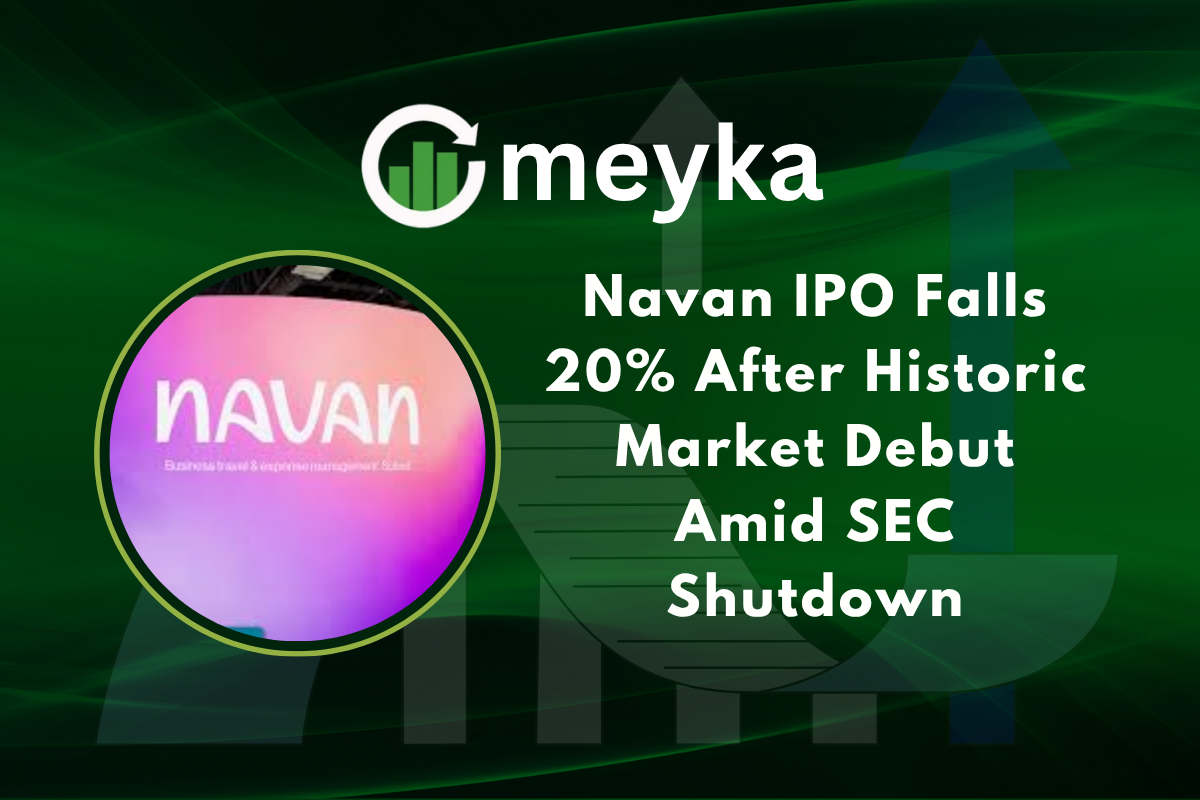Navan IPO Falls 20% After Historic Market Debut Amid SEC Shutdown
Navan, the corporate travel and expense platform formerly known as TripActions, saw its shares tumble after its Nasdaq debut. The Navan IPO priced at $25 per share and raised roughly $923 million, but the stock closed sharply lower on its first day. Market watchers say the partial U.S. SEC shutdown and broader tech caution helped push the drop.
Why did Navan’s first day slide even after a big raise? Many investors point to timing and regulatory uncertainty as key reasons.
Navan IPO: A Bold Market Entry Amid Regulatory Chaos
The Navan IPO came as one of the largest tech listings during a quiet window for public deals. The company aimed for a strong debut after years as a private unicorn. Navan priced its shares at $25, a midpoint of its marketed range, but trading opened below the offer price, and volatility followed.
The U.S. government shutdown limited usual SEC oversight and slowed filings. That added a layer of risk for investors deciding on new tech stocks. Fast Company and other outlets flagged how the timing raised questions for the IPO market.
The Story Behind Navan’s Market Debut
Navan was founded in 2015 by Ariel Cohen and Ilan Twig. The company evolved from TripActions into a broader enterprise platform that blends travel booking, expense management, and payments. Navan serves large clients and has pushed machine learning features into its travel tools.
Still, many investors remain cautious about tech firms that have scale but not steady profits. That caution likely weighed on the Navan IPO on its first trading day.
Investor Sentiment and Market Reaction to Navan IPO
Trading was choppy. Early volume spiked, and the stock fell into the red. By the close, some reports showed declines near twenty percent from the offering price, a sharp move for a major debut. Reuters and Bloomberg noted that investor appetite for new listings was fragile in the current climate.
A social media reaction summed it up: traders said the listing showed how thin confidence can be when markets and regulators are unsettled. Short-term selling and profit-taking added to the pressure.
What Makes Navan Different from Other Tech IPOs?
Navan mixes AI, payments, and travel tech. Its AI-driven tools aim to cut costs and improve booking speed. The company focuses on enterprise clients, which gives it a different risk and revenue profile than consumer apps. Analysts say this mix can pay off over time if markets calm.
In early trading, investors seemed to prefer clearer profit paths, which made the Navan IPO more sensitive to headlines.
The SEC Shutdown Adds Pressure to a Weak IPO Market
The unusual context of an SEC slowdown mattered. With staff furloughed, the normal cadence of pre IPO review and analyst Q&A was disrupted. That created extra uncertainty for institutional buyers and retail traders alike. Analysts noted that IPOs during this period tend to see higher volatility and lower immediate demand.
AI Stock Analysis of recent IPOs suggests that listings amid regulatory stress show amplified price swings. That pattern fit the rough start for Navan.
Social Media Reactions and Market Sentiment
Social platforms lit up with debate. Some posts framed Navan’s debut as a needed test for the IPO market; others saw it as a warning sign. Investors and commentators pointed to valuation gaps and to the timing of public listings as key forces behind the sell-off.
These conversations boosted search interest and trading chatter for hours after the open.
Broader Implications for Tech IPOs in 2025
The Navan IPO may cause other startups to pause plans. When a notable listing stumbles, companies and bankers often reassess timing and pricing. Fast Company and others say this could slow the pipeline until the regulatory picture clears and market confidence returns.
Still, market corrections can create better entry points for long-term investors. If Navan steadies, it could become a case study in patient, post IPO recovery.
Can Navan Rebound from the Initial Drop?
Company leaders are optimistic. Navan’s management points to growth in bookings and in the payments side of its business. If revenue and margins trend as expected, institutional buyers may step in over time. Analysts say to watch quarterly results and client growth to judge recovery.
According to AI Stock Research, investor attention to enterprise software IPOs rose in the weeks before Navan’s listing, showing strong interest despite short-term volatility.
What Investors Should Watch Next
Investors should track a few clear things: trading volumes, insider selling patterns, and Navan’s next earnings report. Also, watch regulatory updates about the SEC and any statements from major institutional buyers.
Those signals will guide whether the Navan IPO becomes a short-term story or a longer-term recovery.
Conclusion: Navan IPO Marks a Stress Test for the Market
The Navan IPO had a rocky start, but it also showed the market is still willing to list large tech names under tricky conditions. The SEC shutdown added risk and made buyers cautious, which helped push the drop. Over the medium term, Navan’s AI-led product mix and enterprise focus could help it recover if macro conditions improve.
AI Stock tools and market trackers will be useful for investors watching Navan’s next moves. For now, the Navan IPO is a reminder that timing matters, and that market structure and regulation can shape the fate of even well-known startups.
FAQ’S
Investors reacted to increased uncertainty from the partial SEC shutdown, plus profit-taking and softer demand than expected. That combination pushed the stock down about 20% by the close.
It depends on your time frame and risk tolerance. Check Navan’s revenue growth, margins, and client base; if you believe in the long-term business case, the dip may be a buying window; otherwise, consult a financial advisor.
The partial shutdown limited regulatory reviews and communications, which raised investor caution. Less clarity and delayed filings made the market more volatile for new listings.
Recovery is possible if markets stabilize, the SEC resumes normal operations, and Navan meets growth and profitability targets. Watch upcoming earnings and institutional buying for signs of a rebound.
Avoid knee-jerk moves; review Navan’s S-1 and financials, set clear goals, and decide based on fundamentals and risk appetite. Consider phased buying or professional advice if you want exposure.
Disclaimer
The content shared by Meyka AI PTY LTD is solely for research and informational purposes. Meyka is not a financial advisory service, and the information provided should not be considered investment or trading advice.






